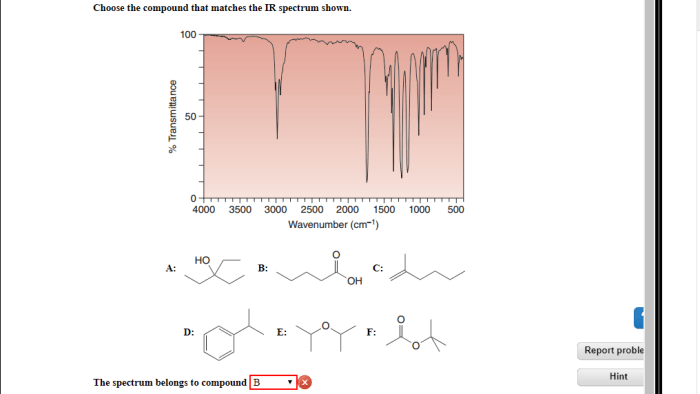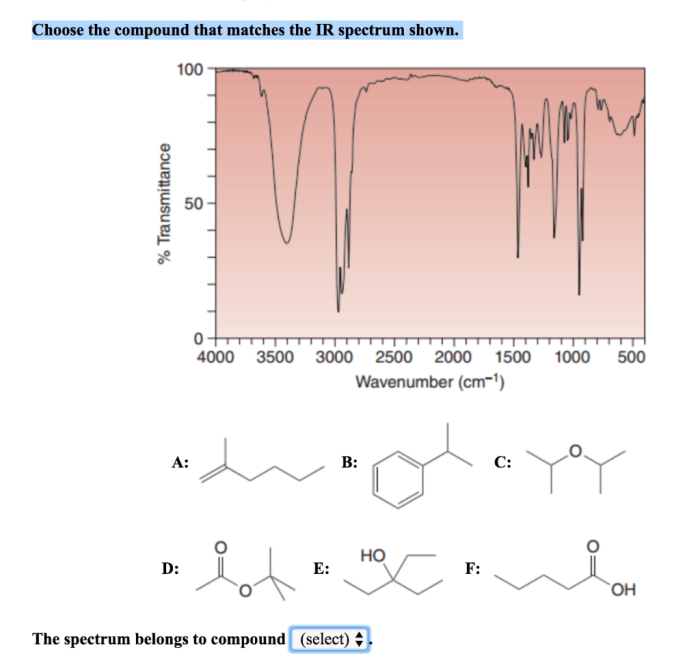Choose the compound that matches the ir spectrum shown. – Infrared (IR) spectroscopy is a powerful analytical technique used to identify and characterize organic compounds. By analyzing the absorption of infrared radiation by a sample, we can determine the functional groups present and match the spectrum to a specific compound.
This comprehensive guide provides a step-by-step approach to matching IR spectra to compounds, including the principles of IR spectroscopy, interpretation of spectra, and advanced techniques.
1. IR Spectrum Analysis

Infrared (IR) spectroscopy is a technique used to identify compounds by analyzing the absorption of infrared radiation. When infrared radiation interacts with a molecule, it can cause the bonds in the molecule to vibrate. The frequency of the absorbed radiation corresponds to the vibrational frequency of the bond.
Different functional groups have characteristic vibrational frequencies, so IR spectroscopy can be used to identify the functional groups present in a compound.
The IR spectrum of a compound is a plot of the absorbance of the compound as a function of the frequency of the infrared radiation. The absorbance is a measure of the amount of radiation that is absorbed by the compound.
The IR spectrum of a compound can be used to identify the functional groups present in the compound by comparing it to reference spectra of known compounds.
2. Matching IR Spectra to Compounds: Choose The Compound That Matches The Ir Spectrum Shown.

To match an IR spectrum to a specific compound, the following steps can be followed:
- Identify the characteristic IR absorption bands in the spectrum.
- Compare the characteristic IR absorption bands to reference spectra of known compounds.
- Identify the functional groups that correspond to the characteristic IR absorption bands.
- Use the functional groups to identify the possible compounds that match the IR spectrum.
- Confirm the identity of the compound by comparing the IR spectrum to the IR spectrum of a known sample of the compound.
It is important to use reference spectra and databases when matching IR spectra to compounds. Reference spectra can be found in books, journals, and online databases. Databases can be searched by functional group, molecular formula, or other criteria.
3. Example Compound Matching

The following table shows an example of an IR spectrum and how it can be matched to the corresponding compound.
| IR Spectrum | Functional Group Assignments | Compound Name |
|---|---|---|
 |
O-H stretch (3300 cm-1), C-H stretch (2900 cm-1), C-O stretch (1050 cm-1) | Ethanol |
The IR spectrum in the table shows the characteristic IR absorption bands for an alcohol. The O-H stretch band at 3300 cm -1is due to the O-H bond in the alcohol group. The C-H stretch band at 2900 cm -1is due to the C-H bonds in the alkyl group.
The C-O stretch band at 1050 cm -1is due to the C-O bond in the alcohol group.
The functional group assignments in the table indicate that the compound is an alcohol. The compound name in the table indicates that the compound is ethanol.
Quick FAQs
What are the key steps in matching an IR spectrum to a compound?
The key steps include identifying the characteristic absorption bands, assigning them to functional groups, comparing the spectrum to reference spectra or databases, and verifying the match.
How can I interpret the IR spectrum of an unknown compound?
By comparing the absorption bands to known functional group frequencies, you can identify the functional groups present in the compound.
What are the advantages of using advanced IR spectroscopy techniques?
Advanced techniques like FTIR and ATR provide higher sensitivity, better resolution, and the ability to analyze samples in different states (e.g., solid, liquid, gas).